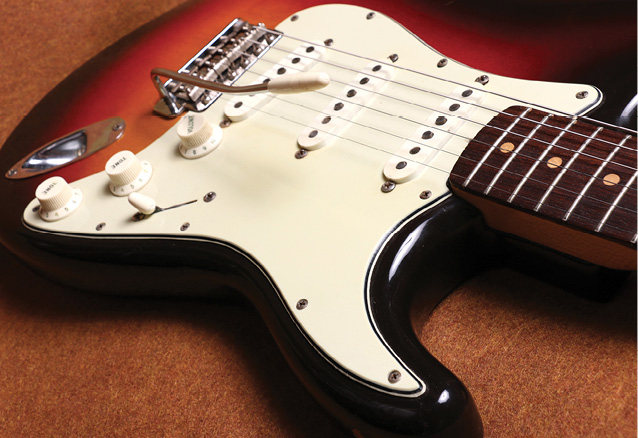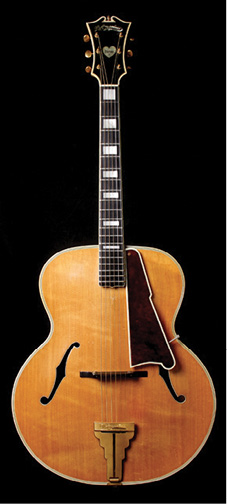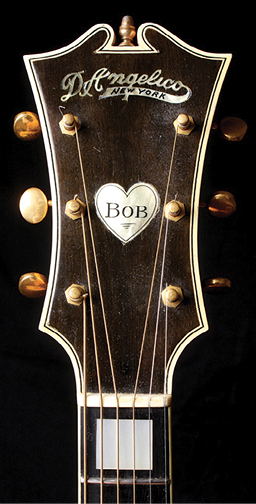16
My advertisements in the LA Times always seemed to pay off nicely. Looking back, I find it amazing just how many wonderful guitars came to me through those ads.
Once I received a call from a man who said he had a very clean, older Fender Stratocaster with a sunburst finish, in “excellent” condition. When I asked him what color the case was, he told me “brown,” and I had to conceal my excitement. A brown case can mean many things, but it usually means we’re talking early-sixties vintage. I could not wait to get directions and make it over to his house. I got in my car and sped as fast as I could to the Long Beach area.

Fender 1962 Stratocaster. (Photo by Jen Angkahan)
When I got there, the man introduced himself as Bob and pulled out the Strat case. He wasn’t kidding. It was super-clean. He popped it open, revealing a stunning slab board Sunburst Stratocaster. Clearly, it had been hardly played, which would put it in the “excellent” condition column in my book. Then he also pulled out a gorgeous brown Fender Concert amp, which was also hardly used. Did I want it? Of course I wanted it.
Then he asked me if I was interested in John D’Angelico guitars. I said absolutely. I tried to keep it cool as I asked him about that guitar.
For those of you who might not be familiar with the name, John D’Angelico was known as the greatest archtop maker of his time. His original designs had been influenced by Gibson, but he ended up building his own “Excels” and “New Yorkers,” which were beautiful art-deco beasts in the forties and fifties, during the heyday of jazz guitar. Almost all of the most well-known players had a “D.A.” Being able to afford one was a sign that you had arrived.


D’Angelico 1942 custom Bob. (Photos by Jen Angkahan)
Bob told me D’Angelico was his uncle, and that “Uncle John” had given him a guitar for his thirteenth birthday. Bob reached into his closet and pulled out an early pebble grained seventeen-inch archtop case. When he pulled out the guitar, I saw that it was a gorgeous blond non-cutaway Excel model. The wood on the back was spectacular and flamed to death. He also pointed at the inlay on the top of the headstock. It was heart-shaped with the name Bob inlaid in the middle of the heart! This was an intimate and personal statement by the master, and I knew immediately I’d never see one like it again and that I had to have it.
I negotiated the best deal I could. I was determined to leave with both guitars and the amp. Bob was aware of the value of them but said he could use the money to do some remodeling of his house. He said he hadn’t played guitar in years and felt this would give him enough money to do what he had to around the house. I bought them all and couldn’t wait to get home to play them. Even to this day, I still have both the guitars and the Concert amp, priceless pieces in my collection.
The bottom line is, my “Top Dollar Paid” ad was a signal to sellers that I knew the value of rare and special guitars. In the early eighties, most local stores wouldn’t know what a D’Angelico even was. Most local stores at the time dealt in new guitars and wouldn’t have even known what was fair market value for a 1962 slab board Strat. But now, thanks to the wonders of the Internet, everybody knows or thinks they know . . .
•••
Another call that came in was an older lady who said she had her late sister’s Martin guitar. Her sister had passed away and left her the Martin. She told me she knew nothing about it, but she believed it was probably from the sixties. Over the phone, I coaxed her to get the guitar and look up at the heel block inside the body to read me the model and serial number. Unfortunately, her eyesight had been failing and she couldn’t get enough light in the guitar to make out what was stamped inside. All right, so no information available there.
Then she told me she felt the guitar was worth about $1,200. I asked her how she came up with that number, and she informed me that she had taken it to a local store and that’s what they told her. They said they did not purchase used guitars but that was their guess as to the value.
Judging from her description of the condition of the guitar, I could tell that it was clean, but I wasn’t excited because without the information on the neck block, it was inconclusive. Also, the fact that a music store had already evaluated it, I felt it could have been from the early seventies. She lived down in Orange County by Knotts Berry farm, which was a schlep for me, and traffic was always a bear. So I made an appointment to see the guitar a couple days later. If I had thought it might be anything special, I would have immediately jumped in my car and drove to her house.
A couple days later, I arrived to see the guitar, and she pulled out the case. It was a much older case than I had anticipated. I had seen lots of guitars in cases that were much older so that didn’t mean anything.
When I popped open the case, I saw a beautiful D-28. I saw that the guitar had a tortoise pickguard and herringbone trim. I saw that it had bar frets, which would’ve predated it to 1934 or 1935. Then I looked at the heel block for the serial number and discovered it was a 1934! This was the first year of production for D-28s. The guitar was in remarkable condition. I didn’t want to get too worked up because in the past I had blown a few deals by acting too excited. I gave the lady her asking price, and I figured I would write down her mailing address and send her an additional check after I got home. I wanted to be fair, but I didn’t want to blow the deal by telling her the guitar was worth much more.
There had been a couple of instances when I told the seller that their guitar was worth much more and they decided if it’s worth that much maybe they would not sell it. So I had learned from my mistakes. At the time, the guitar was worth between $10,000 and $12,000. I mailed her a check for an additional sum, and I almost immediately sold the guitar for $12,000.
You don’t want to know how much that guitar is worth today. Of course, with hindsight, I wish I had kept it, but at the time, I made an outstanding profit. Sometimes the businessman supersedes the collector in me. I’m sure that if the local music store she went to made her any kind of offer, they could have purchased the guitar for much less. It’s amazing to me that a store wouldn’t at least do a little research and see what they were passing on.
•••
I regret to say that stumbling across a rare bird like that is increasingly unlikely in this modern age. It really was “the Wild West” back then. The newspapers were a prime source for classified ads. There was a lot of promotion for their classified section, and people waited with great anticipation for the newspapers to come out, especially the Sunday editions. The Sunday editions were generally many times larger than the weekly classified ads. Garage and estate sales were plentiful and it was a great outlet for people to sell their things. There were also publications such as the Penny Saver, Nifty Nickel, White Sheet, and eventually the Recycler, solely dedicated to classified ads.
I already told you how I used to follow the trucks coming out of the LA Times in order to catch the first drop off of the newspapers. I discovered that the Sunday LA Times always appeared on Saturdays. Of course it was Saturday’s news, but with Sunday’s classifieds. I would get the papers, mark the ads that I was interested in, and start making calls on a pay phone. (Remember those?) Sometimes people were pretty upset that I was calling so early, so I’d have to lie and say I was going to work, but that I had cash on me and would like to come by and pick up the guitar before work. If the ad was really special, I would sometimes recruit Marlene to wait for a little while and then call about the ad, pretending she was a different potential buyer. This was before call waiting, so I wanted to tie up those telephone lines so no one else could call.
Marlene would start asking a lot of rudimentary questions, like how many strings the guitar had, what color it was, and other dull, ignorant things, just to keep the conversation going and tie up the line. She also would ask why they were selling the guitar, how long they had the guitar, et cetera. They would generally say, “There is a guy coming over to look at the guitar” but she would continue asking questions. She’d really drag it out and was expert at doing this.
At the very end of their conversation, she would say, “I’m sorry, but this is not what I was interested in!” By this time hopefully I was pulling into their driveway. Eventually, after answering a lot of stupid questions and being hassled, they were glad to sell their guitar to me, so they wouldn’t have to deal with it anymore and be bothered by answering anyone else’s stupid questions!
Eventually I searched out someone working at the LA Times and gave them a kickback if they helped me by giving me information about the ads before they came out. I did whatever it took to land the big score. When I was younger, I played a lot of sports, which taught me strategy. Strategy can be trickery or deception. I definitely am not telling anyone to break the law, but slightly bending the rules can be very profitable.
•••
In the early eighties, the Recycler became a game changer overnight. It would come out Thursday mornings around 7:00 a.m. The main office was in Sherman Oaks, about seven miles from my house. On Thursday mornings, I would go down to the Recycler office, coffee in hand, and buy every edition—the Valley, Los Angeles, San Gabriel, and even Palms Springs and Orange County. I would start with the editions close by and would work my way through all of them no matter how far away.
Eventually a lot of people began using the Recycler to buy stuff and the lines at 7:00 a.m. starting going around the block. There were people looking to buy cars, antiques, houses, sporting goods, and everything else under the sun. After a while, there were other people looking to buy guitars in line with me at the Recycler, and the competition became quite fierce. When folks become aware that something is profitable, competition arises. I remember one guy was only interested in Marshall amps. We were not going for the same things, and so we generally stayed out of each other’s way.
When looking through the ads, you had to move quickly. I would earmark the ads that were most important and make my calls according to priority. Sometimes if the locations were far away, I had to ask the seller to give me his word that he would hold his goods until I arrived. I would say, “Give me until 9:00 a.m., please,” just to give me a chance to get there. I would assure the seller that I was serious and coming with cash.
This went on for quite a few years, and it seemed like each week there were more people waiting in line. Even though the competition was strong, it was very exciting. It always felt like I was prospecting. You never knew what treasure you might dig up. One thing I learned was always to ask if they had anything else they wanted to sell. Sometimes the thing I primarily came for was nothing compared to something else I found there. Sometimes the seller needed to be persuaded to sell other guitars. I always came with cash in hand just in case there were more things that became available. Some of my best acquisitions were secondary ones.
•••
I never put a time limit on how long I was willing to work. This certainly was not just a 9-to-5 job. If I got a call back from San Diego and it was midnight, I got in my car and went on my way. Eventually things changed with Craigslist, eBay, and all the other Internet sources. Even the LA Times and the Recycler began posting online classifieds. These ads posted immediately so people didn’t have to stand in line waiting to purchase their newspaper editions. I truly believe that if these newspapers delayed posting ads until, let’s say, Thursday, people would once again wait anxiously to buy goods.
If you look at the Times classifieds these days, it is mainly dealer ads. The classified section is now so small, it is only a fraction of the size it once was. There are very few private-party ads. There is no need to buy the publications if ads are already posted online. I think newspaper sales would improve if the ads were only released on a certain day. Even the Recycler to this day is a much smaller publication, with much fewer ads. Posting their ads online does not build up demand like they once had. Even if the papers gave private parties free ads in order to build up these classified sections, I believe it would give more folks a reason to buy their publications. But the newspaper business isn’t a growth industry anymore, and that’s depressing to me.